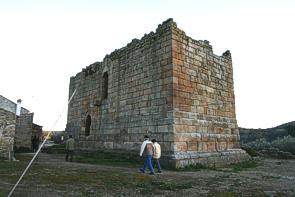The peaceful little village of Idanha-a-Velha in Portugal some 40KMS East of Alcantara on the Spanish border and 150kms from Finca al-manzil, has an illustrious past.
It was founded by the Romans and surrounded by an impressively solid stone defensive wall which still exists today. Then it was the Episcopal see under the Visigoths in the VI century before sinking back into obscurity following the Moorish invasion in the VIII century.
It is said to have been the birthplace of a Visigoth king with its own bishops at the cathedral which was restored at the beginning of the 16th century but thankfully still preserves inscribed and sculpted Roman stones. One of them dating from 16 B.C. links this Roman town of Igeditanos to Extremadura, it reads "Quintus Iallius, a citizen from Emerita Augusta (Mérida) has willingly given a sundial to Igeditanos"
In the Visigoth era, under the name of "Egitânea", the village witnessed a golden age, it became a diocese in 599 and was also gold coin mint. Nowadays all that is left are the ruins of the baptistry, the bishop's palace and the sé (cathedral).
It seems so odd, all that former Roman and Visigoth grandeur existing in this sleepy little village with maybe 20 inhabitants today. The ghostly aire is emphasized by a rambling dilapidated 20th century mansion owned by the Marrocos family, it looks as if it has been deserted for years and years, slowly decaying, chunks of stonework fallen and intricate woodwork rotting away. Apparently the family owned thousands of hectares of farmland in the area and evidently had to run away to Brazil at the time of the revolution in 1974 when the workers, in truth merely serfs, took over large estates all over Portugal. A little square in front of the eerie rural palace is dominated by a mulberry tree, obviously the local gossip place where we found out about the history of the mansion whilst indulging in a good old gossip. Aparently the mansion has been acquired by the local council and there are plans for renovation and conversion into a museum of local enthnology, I do hope this will happen.
From Largo de Amoreira (Mulberry tree square) a passage way leads to the Lagar de Vares, an ancient olive oil mill, an interesting part of the industrial archaeology of the area. This recently renovated space shows a first room with two great pressing bars and a boiler; in the next room you can see the olive oil storage tank and the milling place
We walk back through the Roman stones and a little way along the top of the massive 745 metre long Roman wall that surrounds the village, then down to the area outside the walls where a beautiful little chapel sits guarded by the dove of the holy spirit.








No comments:
Post a Comment
Follow the latest news from Finca al-manzil- What to do and see in Extremadura and Beyond.............